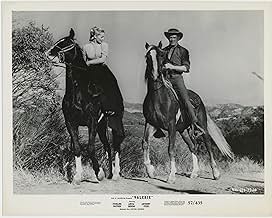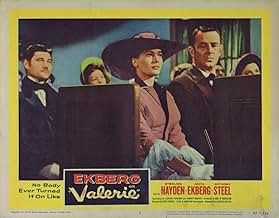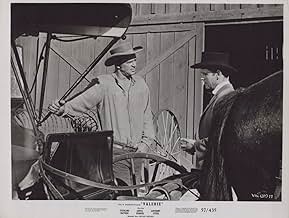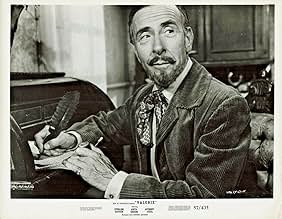Füge eine Handlung in deiner Sprache hinzuAfter the American Civil War, former Union Major John Garth marries pretty settler Valerie but tragedy strikes and the two spouses end up in court where they give two different conflicting a... Alles lesenAfter the American Civil War, former Union Major John Garth marries pretty settler Valerie but tragedy strikes and the two spouses end up in court where they give two different conflicting accounts of their marriage.After the American Civil War, former Union Major John Garth marries pretty settler Valerie but tragedy strikes and the two spouses end up in court where they give two different conflicting accounts of their marriage.
- Regie
- Drehbuch
- Hauptbesetzung
Jered Barclay
- Mingo
- (as Jerry Barclay)
Chet Brandenburg
- Trial Spectator
- (Nicht genannt)
John Dierkes
- Bartender
- (Nicht genannt)
Rudy Germane
- Court Clerk
- (Nicht genannt)
Empfohlene Bewertungen
I had never heard of this movie before, and had not really seen any of the actors (I did recognize Gage Clarke, aka Mr. Botkin of "Gunsmoke.")
This is Alfred Hitchcock-style comes to the West. Do I believe her? Do I believe him? Who is telling the truth? Is the Reverend being honest? Is the brother? Is she a seductress? Is she a victim?
The suspense builds to an undeniable conclusion! I really enjoyed this movie and actually want to see it again!
This is Alfred Hitchcock-style comes to the West. Do I believe her? Do I believe him? Who is telling the truth? Is the Reverend being honest? Is the brother? Is she a seductress? Is she a victim?
The suspense builds to an undeniable conclusion! I really enjoyed this movie and actually want to see it again!
The western was generally a male-dominated genre, so it is unusual to come across one bearing the name of a female character for its title. Even a film like Nicholas Ray's "Johnny Guitar", which features two strong women played by Joan Crawford and Mercedes McCambridge, bears the name of one of the male characters. "Valerie", however, is not a typical western. Most westerns from the fifties tended to revolve around a few well-worn themes- Cavalry versus Indians, lawman versus outlaws, wagon train, range war over grazing rights, cattle drive, etc. This one is different. Indeed, it might be more accurate to describe it not as a western but rather as a courtroom thriller or domestic melodrama which just happens to be set in the Old West. Unlike most westerns, the story could, with only a few minor changes of detail, be transferred to virtually any other part of America- or, indeed, to many other countries- at virtually any other period in history. This perhaps explains why it was made in black-and-white; although colour was increasingly becoming the norm for traditional westerns in the late fifties, monochrome was still commonly used for psychological dramas.
As the film opens, a wealthy rancher named John Garth is tried for shooting his beautiful young Hungarian-born wife Valerie, critically wounding her, and murdering her parents. Most of the story is told in a series of flashbacks, using for a framework the testimony given in the courtroom by various characters. The two main witnesses are Garth himself and Valerie, who has by now recovered sufficiently to give her evidence from her hospital bed. As might be expected, the two give very different accounts of their marriage. His testimony is that she was a cold, unloving wife who was unfaithful to him with his own brother and with the local preacher, the Reverend Blake, that her parents constantly interfered in the marriage and that the shooting was either a crime of passion or self-defence. She testifies that he was a brutal, foul- tempered husband who wrongly and unreasonably accused her of adultery in an attempt to justify the violence he wreaked on her in his frequent rages.
The film has been compared to Kurosawa's influential "Rashomon", which also told its story from several different viewpoints, although as another reviewer points out, there is a difference. In Kurosawa's film the various conflicting viewpoints were all presented as equally valid, implying that truth is something subjective, whereas here truth is treated more objectively. One of the parties is telling the truth and the other is lying. Which of the accounts is true and which is false is revealed in the final denouement.
This made Valerie a difficult role to play, as the actress playing her needed, effectively, to play two quite different characters, both the innocent wronged wife which Valerie claims to be and the heartless, promiscuous seductress which is how her husband depicts her. The role therefore needed someone more accomplished than the Swedish sex symbol Anita Ekberg who always, or so it seemed to me, got by more on looks than on talent, at least in her English-language movies. (She was perhaps fortunate that the early part of her career came in the fifties, at a time when the film industry seemed particularly obsessed with voluptuous blondes- Monroe, Dors, Mansfield, Bardot, Van Doren, et al.) Here she is rather disappointing, failing to portray either of the two Valeries with any great conviction. Sterling Hayden, however, is more convincing as Garth, possibly because the difference between the two versions of Garth's character is not as great. Even on his own testimony Garth is an unhappy, tormented man, haunted by memories of the Civil War in which he was responsible for torturing Confederate prisoners in order to extract information from them. The Reverend Blake is played by Ekberg's real-life husband, Anthony Steele.
I had never heard of this film until I caught it when it was recently shown on television, and I note that mine is only the third review it has received, suggesting that it is not very well known. Yet despite the weakness of its leading actress, I feel that this is one of those westerns that deserves to be better known. Its German-born director Gerd Oswald handles his material well and the unusual subject-matter makes the film a welcome and refreshing change. 7/10
As the film opens, a wealthy rancher named John Garth is tried for shooting his beautiful young Hungarian-born wife Valerie, critically wounding her, and murdering her parents. Most of the story is told in a series of flashbacks, using for a framework the testimony given in the courtroom by various characters. The two main witnesses are Garth himself and Valerie, who has by now recovered sufficiently to give her evidence from her hospital bed. As might be expected, the two give very different accounts of their marriage. His testimony is that she was a cold, unloving wife who was unfaithful to him with his own brother and with the local preacher, the Reverend Blake, that her parents constantly interfered in the marriage and that the shooting was either a crime of passion or self-defence. She testifies that he was a brutal, foul- tempered husband who wrongly and unreasonably accused her of adultery in an attempt to justify the violence he wreaked on her in his frequent rages.
The film has been compared to Kurosawa's influential "Rashomon", which also told its story from several different viewpoints, although as another reviewer points out, there is a difference. In Kurosawa's film the various conflicting viewpoints were all presented as equally valid, implying that truth is something subjective, whereas here truth is treated more objectively. One of the parties is telling the truth and the other is lying. Which of the accounts is true and which is false is revealed in the final denouement.
This made Valerie a difficult role to play, as the actress playing her needed, effectively, to play two quite different characters, both the innocent wronged wife which Valerie claims to be and the heartless, promiscuous seductress which is how her husband depicts her. The role therefore needed someone more accomplished than the Swedish sex symbol Anita Ekberg who always, or so it seemed to me, got by more on looks than on talent, at least in her English-language movies. (She was perhaps fortunate that the early part of her career came in the fifties, at a time when the film industry seemed particularly obsessed with voluptuous blondes- Monroe, Dors, Mansfield, Bardot, Van Doren, et al.) Here she is rather disappointing, failing to portray either of the two Valeries with any great conviction. Sterling Hayden, however, is more convincing as Garth, possibly because the difference between the two versions of Garth's character is not as great. Even on his own testimony Garth is an unhappy, tormented man, haunted by memories of the Civil War in which he was responsible for torturing Confederate prisoners in order to extract information from them. The Reverend Blake is played by Ekberg's real-life husband, Anthony Steele.
I had never heard of this film until I caught it when it was recently shown on television, and I note that mine is only the third review it has received, suggesting that it is not very well known. Yet despite the weakness of its leading actress, I feel that this is one of those westerns that deserves to be better known. Its German-born director Gerd Oswald handles his material well and the unusual subject-matter makes the film a welcome and refreshing change. 7/10
"Valerie" is a movie that only gets better the more you watch of the film. Up until the last 15 minutes or so, I wasn't that impressed with the story (or Miss Ekberg's acting) but it all got very exciting towars teh end...making it well worth seeing.
The story begins with a mass murder. John Garth (Sterling Hayden) leaves a home after a shooting which left three people dead and his wife shot and close to death. The film shows both his account and hers of the events leading up to the shooting...a shooting he claims was in self defense. What really happened?
In some ways, this story is like the classic Japanese film "Rashomon", though instead of three viewpoints you have two...and teasing apart what REALLY happened is a bit easier in "Valerie". It's a simpler story...but still well done. As I mentioned above, my only quibble was some of Ekberg's acting....it often wasn't great and her accent was a bit thick, so, if possible, watch with captions.
The story begins with a mass murder. John Garth (Sterling Hayden) leaves a home after a shooting which left three people dead and his wife shot and close to death. The film shows both his account and hers of the events leading up to the shooting...a shooting he claims was in self defense. What really happened?
In some ways, this story is like the classic Japanese film "Rashomon", though instead of three viewpoints you have two...and teasing apart what REALLY happened is a bit easier in "Valerie". It's a simpler story...but still well done. As I mentioned above, my only quibble was some of Ekberg's acting....it often wasn't great and her accent was a bit thick, so, if possible, watch with captions.
I've seen another movie entitled "Valerie" but it was a bit different from movie I saw last with same actors, and actress! The story was similar in that the husband thought his wife was cheating on him with his brother and with their church pastor. I remember events being different how Sterling Hayden told Valerie that he paid her parents for her hand, not they paid him. Her parents didn't have a lot of money. True that she didn't love him cause she was courting both his brother outright, and the pastor on the sneak. I'm NOT understanding why if he had lots of valuable land then why would he accept money from her parents selling Valerie to him?!? He wasn't a poor man! I know this is weird but I know I watched two different versions of this movie at different times. The first time I watched movie I DIDN'T catch it from the beginning but saw enough to remember movie. The second one I saw last night was a bit different. The same storyline and characters but the details were a but different.😒🤔
Valerie is directed by Gerd Oswald and written by Leonard Heiderman and Emmett Murphy. It stars Sterling Hayden, Anita Ekberg and Anthony Steel. Music is by Albert Glasser and cinematography by Ernest Laszlo.
John Garth (Hayden) is arrested and put on trial for the wounding of his wife Valerie (Ekberg) and murder of her parents. The trial hinges on three testimonies, each telling in flashback what actually unfolded to lead up to the bloodshed. But who is telling the truth?
Set in the West, a murder mystery with a noirish edge, with crisp black and white photography keeping things in the ream of sombre, Valerie is a mixed bag. Yet it works as entertainment, the screenplay has some surprises in store, where it's not afraid to paint a world of wanton desires, seedy suspicions, violent mistreatment and possible war tainted masochistic tendencies. The court case at the centre of tale throws up the sometimes fragility of the law, with some biased spice and hurtful hearsay added into the mix, and it all builds nicely to a dramatically bleak finale.
Hayden delivers one for his fans, all straight backed machismo and menacing drawl, and Ekberg scores well as a scenic beauty who deftly pulls off a dual portrayal that calls for seduction or victim credibility. Steel, Ekberg's real life beau, is a bit lightweight but doesn't harm the drama, while there's not much airy landscapes to enjoy (filmed on location at Iverson Ranch in Chatsworth). Still, this is very much one for fans of the stars to seek out, whilst noir and Western fans will find pleasures too. 7/10
John Garth (Hayden) is arrested and put on trial for the wounding of his wife Valerie (Ekberg) and murder of her parents. The trial hinges on three testimonies, each telling in flashback what actually unfolded to lead up to the bloodshed. But who is telling the truth?
Set in the West, a murder mystery with a noirish edge, with crisp black and white photography keeping things in the ream of sombre, Valerie is a mixed bag. Yet it works as entertainment, the screenplay has some surprises in store, where it's not afraid to paint a world of wanton desires, seedy suspicions, violent mistreatment and possible war tainted masochistic tendencies. The court case at the centre of tale throws up the sometimes fragility of the law, with some biased spice and hurtful hearsay added into the mix, and it all builds nicely to a dramatically bleak finale.
Hayden delivers one for his fans, all straight backed machismo and menacing drawl, and Ekberg scores well as a scenic beauty who deftly pulls off a dual portrayal that calls for seduction or victim credibility. Steel, Ekberg's real life beau, is a bit lightweight but doesn't harm the drama, while there's not much airy landscapes to enjoy (filmed on location at Iverson Ranch in Chatsworth). Still, this is very much one for fans of the stars to seek out, whilst noir and Western fans will find pleasures too. 7/10
Wusstest du schon
- PatzerAt 53 minutes in when Valerie and John are out riding, John gets off his horse to open the gate; as he moves toward it, the shadows of the camera and cameraman are visible on the ground.
Top-Auswahl
Melde dich zum Bewerten an und greife auf die Watchlist für personalisierte Empfehlungen zu.
Details
- Laufzeit
- 1 Std. 22 Min.(82 min)
- Farbe
- Sound-Mix
Zu dieser Seite beitragen
Bearbeitung vorschlagen oder fehlenden Inhalt hinzufügen































